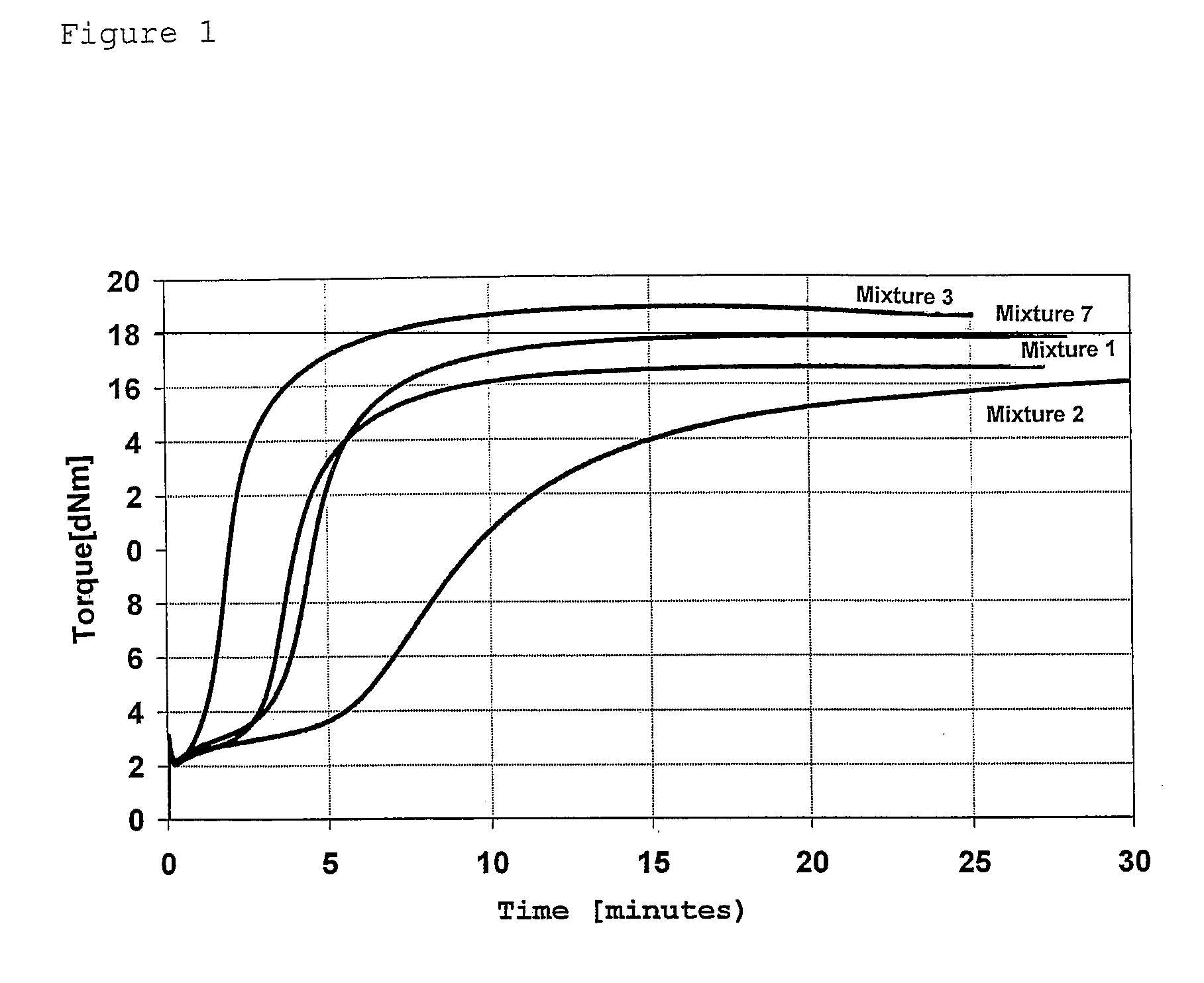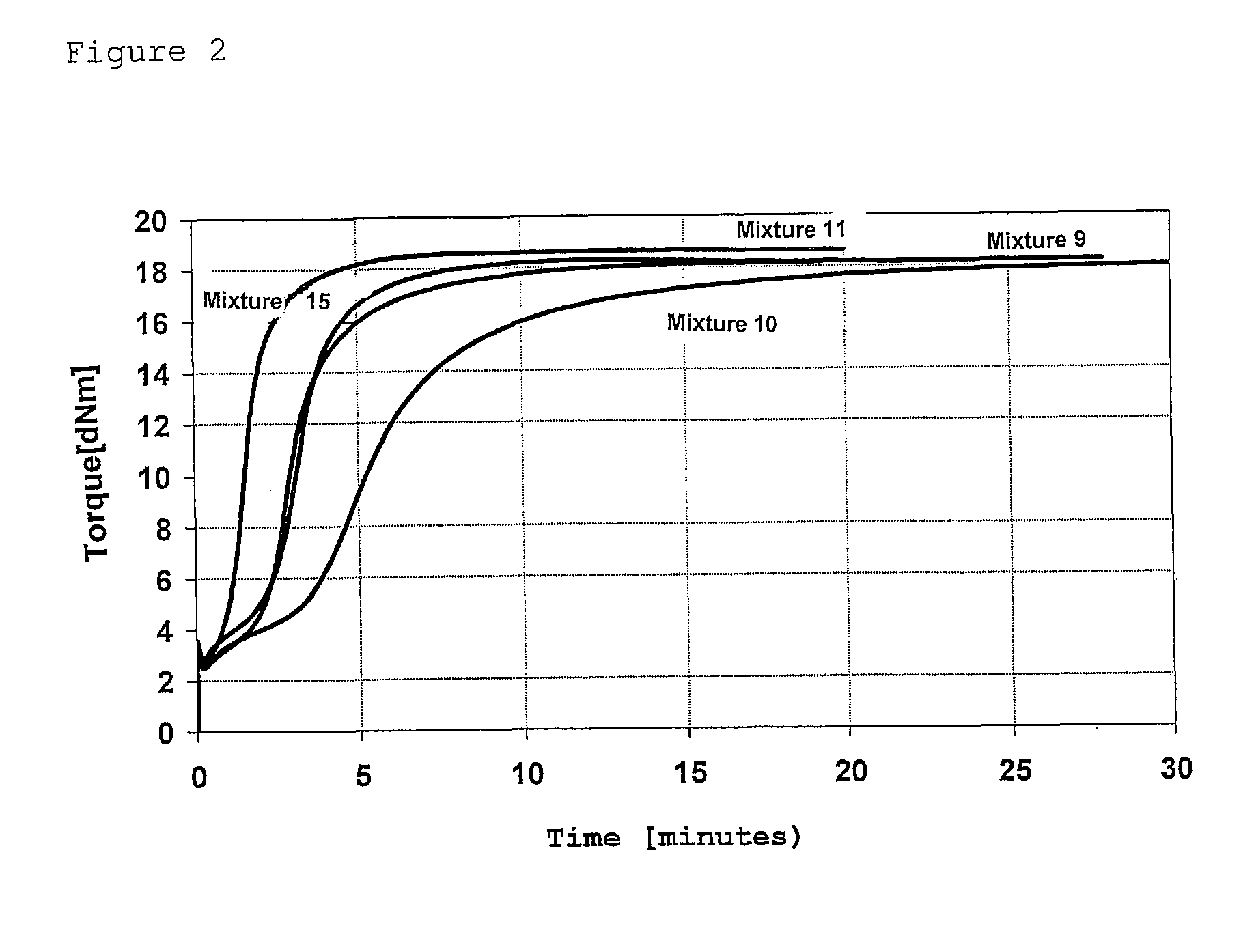Rubber mixtures
a technology of rubber mixtures and mixtures, applied in the direction of dyeing process, transportation and packaging, organic chemistry, etc., can solve the problems of stoichiometry and limit the mixing temperature of rubber mixtures to the temperature range of 140 to 165° c, and achieve good vulcanization behavior
- Summary
- Abstract
- Description
- Claims
- Application Information
AI Technical Summary
Benefits of technology
Problems solved by technology
Method used
Image
Examples
example 1
[0188]400 g of bis(triethoxysilylpropyl)polysulphide Si 69 from Degussa AG are mixed in a distillation apparatus with 224.2 g of triethanolamine, 2 g of 2,6-di-tert-butyl-4-methylphenol (Ionol CP) and 0.6 g of titanium tetrabutoxide at room temperature. The oil bath used for heating is heated to 100° C. and ethanol produced is removed by distillation at 200 mbar. After about 150 ml of ethanol have been removed by distillation, the temperature of the oil bath is increased to 160° C. and the pressure is lowered to 100 mbar. When distillation gives no further ethanol, the mixture is heated for a further 120 min at 160° C. and 50 mbar. 2 g of 3-glycidyloxypropyl(triethoxysilane) (Dynasylan GLYEO from Degussa AG) are then added and the mixture is stirred for a further 30 min at 160° C. in vacuo. The black product is poured under argon into a coated mould and solidifies. The product obtained is 403.5 g of a black solid.
[0189]According to 1H NMR analysis, the product comprises 29.8% by wei...
example 2
[0191]400 g of bis(triethoxysilylpropyl)polysulphide Si 261 are mixed in a distillation apparatus with 247.7 g of triethanolamine and 1 g of titanium tetrabutoxide at room temperature. The oil bath used for heating is heated to 150° C. and ethanol produced is removed by distillation at from 200 to 600 mbar. The internal temperature rises within a period of 180 min from 135° C. to 148° C. After the distillation process has ended, the brownish product is poured under argon into a coated mould and solidifies. The product obtained is 420.1 g of a dark brown solid.
[0192]According to 29 Si NMR analysis, the product comprises 8.7% by weight of bis(silatranylpropyl)monosulphide, 77.2% by weight of bis(silatranylpropyl)disulphide, 12.6% by weight of bis(silatranylpropyl)trisulphide and 1.5% by weight of bis(silatranylpropyl)tetrasulphide. The average chain length determined for the polysulphide mixture is 2.1 (the S1-S10 average value being taken).
example 3
[0193]400 g of bis(triethoxysilylpropyl)polysulphide Si 262 are mixed in a distillation apparatus with 247.7 g of triethanolamine and 0.7 g of titanium tetrabutoxide at room temperature. The oil bath used for heating is heated to 160° C. and ethanol produced is removed by distillation at from 50 to 400 mbar. The internal temperature rises within a period of 90 min to 159° C. After the distillation process has ended, the black product is poured under argon into a coated mould and solidifies. The product obtained is 413.7 g of a brittle black solid.
[0194]According to 29Si NMR analysis, the product comprises 70.2% by weight of bis(silatranylpropyl)disulphide, 22.0% by weight of bis(silatranylpropyl)trisulphide and 3.1% by weight of bis(silatranylpropyl)tetrasulphide. The average chain length determined for the polysulphide mixture is 2.3 (the S1-S10 average value being taken).
PUM
| Property | Measurement | Unit |
|---|---|---|
| molar masses | aaaaa | aaaaa |
| temperatures | aaaaa | aaaaa |
| temperature | aaaaa | aaaaa |
Abstract
Description
Claims
Application Information
 Login to View More
Login to View More - R&D
- Intellectual Property
- Life Sciences
- Materials
- Tech Scout
- Unparalleled Data Quality
- Higher Quality Content
- 60% Fewer Hallucinations
Browse by: Latest US Patents, China's latest patents, Technical Efficacy Thesaurus, Application Domain, Technology Topic, Popular Technical Reports.
© 2025 PatSnap. All rights reserved.Legal|Privacy policy|Modern Slavery Act Transparency Statement|Sitemap|About US| Contact US: help@patsnap.com



